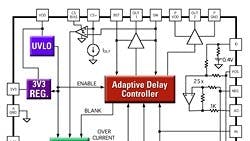A new pair of chips from Texas Instruments (TI) leverage digital control capabilities that are specifically optimized for Point-of-Load (POL) converters. The UCD9111 (single phase) and UCD9112 (dual phase) digital controllers feature user-programmable digital control that is configured entirely through a GUI interface. The controllers interface to one or two UCD7230 digital power driver ICs, depending on the number of phases.
While these components were designed to be combined to form a simple digital power solution, many of the capabilities are provided from advanced analog circuits within the devices. For example, the UCD7230, a 2-MHz synchronous buck driver with high- and low-side 4-A drivers, includes an integrated 3.3-V linear regulator. Therefore, unlike conventional gate drivers, this driver IC not only receives signals from the controller, but can also supply the regulated 3.3 V and UVLO for the controller to which it is interfaced.
The digital driver also includes two precision current references. According to Steve Bakota, manager of digital power business at TI, these references enable two important current monitoring features. One feature is a 25-ns short circuit protection feature that protects the main switching devices against short circuits. The other is a differential current-sensing capability that can measure (and limit to a user-programmable level) the average phase current. When two drivers and a single UCD9112 are used to implement a dual-phase regulator, this feature allows current balancing between the two phases to within 5%.
The UCD9111 and UCD9112 are true digital power controllers, and also include full support for the PMBus protocol. This provides an effective way to enable digital power management features.
According to Bakota, today’s sub-micron IC processes are driving ASICs and processors to tighter regulation requirements from the power supply. Precision requirements for 1.5% voltage regulation across line, load and temperature are becoming increasingly common. These new controllers from TI target this performance, as well as a transient response of within one-seventh to one-eighth of a switching clock period. These are also typical performance targets for analog POLs.
Like the UCD7230, many of the capabilities of the UCD9111 and UCD9112 controllers are provided with unique internal analog circuitry. Perhaps the most remarkable aspect of these capabilities is the on-board switching oscillator that provides the timing signals used to derive the PWM switching and support for 175-ps PWM edge placement. This oscillator operates at 33 MHz with a jitter of only 0.1% across voltage and temperature, yet the entire controller IC consumes only 10 mA. The sophistication of the oscillator circuit can be more fully appreciated when considering that the operating temperature range for the controllers is -40°C to 125°C. This temperature range was defined based on customer requests.
Samples of TI’s UCD9111 and UCD9112 digital power controllers will be available in a 32-pin QFN package in the fourth quarter of 2006. Suggested pricing for the devices in quantities of 1000 units is $2.95 for the UCD9111 and $3.35 for the UCD9112. The UCD7230 is sampling in a 20-pin QFN package with a price of $0.80 in quantities of 1000 units. Volume production for all products is expected in the first quarter of 2007.
Certainly the GUI used to configure the digital control loop is a critical part of the solution provided by the combination of these parts. Unfortunately, there is no similar GUI to smooth out the transient response of the power electronics industry as it shifts from analog to digital power control.
